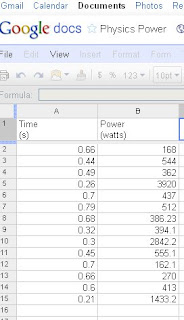Being the extreme science fiction fan that I am, I have always favored Iron Man as my favorite superhero. Not only does he fight crime, but he fights crime...
with science. Or so I thought. A few years ago I found myself in the seat of a movie theater, revving up my action engines and preparing for the onslaught of awesomeness the
Iron Man movie planned to deliver. With this superhero brought to the silver screen, however, I found myself mumbling under my breath about how just about everything he was doing was physically impossible. Or was it? By making a few assumptions about his fictional technology, I decided it was time to make a few calculations. Thus, this short series was born.
Over the next few weeks, I will be occasionally be posting a physics question regarding Iron Man's comic book and "big screen" technology. This, of course, is the first post.
Today's question is about Tony Stark's (Iron Man's actual name) flight. This is truly a spectacle to behold, and one of the original purposes for the creation of the suit, according to the film. In fact, it was this very feature that allowed Tony to escape the terrorists in the film! But let's take a closer look at that scene...
During the scene, Tony builds a gigantic robot that needs the help of mechanical power in order to actually allow it to move easily. In other words, it weighed a lot. So, with the assumption that his main resources was stainless steal (The terrorists were supplying him, remember!), the suit probably had a mass of about 2,360 kilograms. This includes the many dense plates of armor that he was wearing, along with the weapons, and the fuel reserves. Tony, being an average human adult male probably weighed about 75 kilograms.

Later in the scene, Tony walks outside of the cave he was trapped inside, and, in a way to escape the terrorists, uses his first rocket boots about 20 meters from the mouth of the cave to propel himself into the air. Unfortunately, Tony is only able to sustain his flight for roughly 7 or so seconds.
This brings us to question #1: How much force was actually needed to lift the first Iron Man (Tony in the prototype suit) off the ground? This is assuming that the acceleration of gravity in the Middle East is 9.8 m/s^2.
Now for question #2: Assuming that he is able to obtain enough force to instantly accelerate him to a flight speed of 90 m/s, and he sustains this speed for the length of his flight, how high will Tony get before he runs out of fuel if he launched himself at a 35 degree angle?
Question #3: At the top of his flight, Tony runs out of fuel. From here he falls down onto the ground in a crash. Assume that Tony leveled himself out the moment he ran out of fuel. How far from the mouth of the cave is he at this point, assuming he traveled in one direction?
Question #4: How fast will Tony be falling just before he hits the ground?
Now, lets look at how much force his rocket boots are creating.
Question #5: How much force would be needed for Tony to lift off of the ground WITHOUT the suit?
Final Question, #6: How many times more is needed for a suited Tony to lift off as compared to an unsuited Tony?
Discuss your findings. It's kind of ridiculous.








































